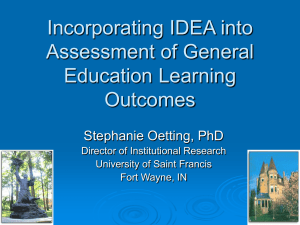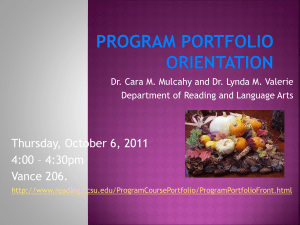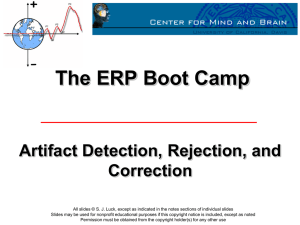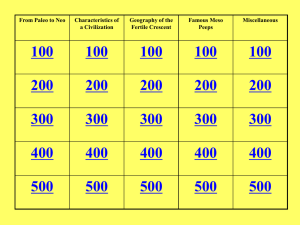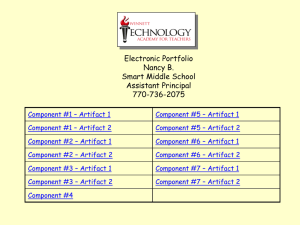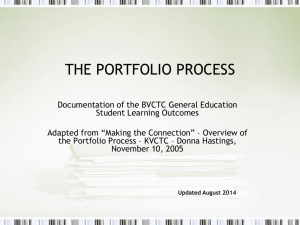High Quality/Leverage Artifacts
advertisement
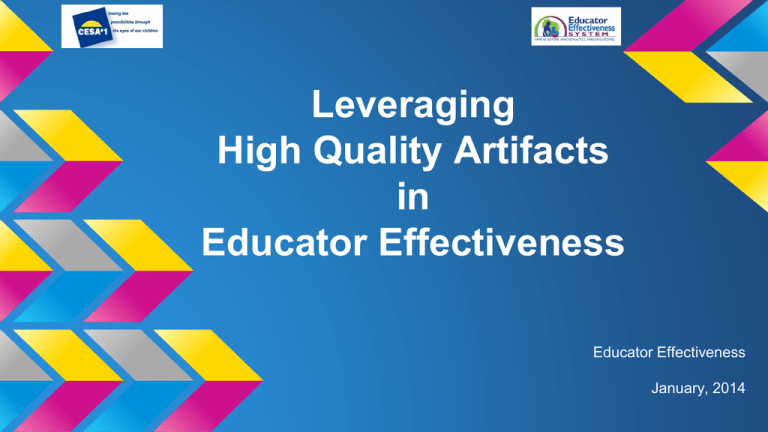
Leveraging High Quality Artifacts in Educator Effectiveness Educator Effectiveness January, 2014 Goals: ● Delineate the difference between artifacts and evidence ● Discuss chararacteristics of high quality high leverage artifacts Tables What is the difference between an artifact and evidence? Come up with a definition for each Delineating between Artifacts and Evidence Evidence of Educator Practices is captured in two ways: through observations of the educator by his or her evaluator, and by educators uploading artifacts and tagging evidence in Teachscape to a component on the appropriate framework. Evidence ● Statement ● What may be seen or heard ● Describes an event/artifact Artifact ● Object, tangible ● Created by person ● Little meaning when stands alone Oh….Ah Ha! Not all evidence has to have an artifact, but ALL artifacts have to have an evidence statement. Each component will have EVIDENCE, but not necessarily an artifact. Wait What? Not all evidence has to have an artifact, but ALL artifacts have to have an evidence statement. Each component will have evidence, but not necessarily an artifact. Example: 4d Participating in the Professional Community. I am a member of site council which is evidence that I participate in school initiatives and partner with colleagues to share and plan for student success. Site council meets monthly and is responsible for developing the school goals and action plans to meet those goals. No, but seriously….What do I HAVE to have? For domains 1 and 4: • each component needs to have an artifact with an evidence statement OR an evidence statement • When in doubt of whether you should have an artifact, check with your evaluator What the What? Now that I know what the difference is between artifacts and evidence…. How do I know if the artifact or evidence is high quality or high leverage? Give it to me Straight Up! Characteristics of high quality: • • • • • Clearly labeled with domain and component it represents (tag) Specific in wording so the evaluator understands the connection to the domain/component (and so you remember why you chose it!) Shows growth for students and teacher Shows teacher reflection Represents your BEST Bang for your Buck Characteristics of high leverage: • Crosses multiple domains and/or components • Has multi purpose or could be used for evidence of SLO, PPG, and/or teacher practice Sample Artifact See the sample team meeting minutes • Which components in domain 4 could this artifact demonstrate? Considerations for Artifact Selection What impact on student learning does this artifact demonstrate? ! What impact on your professional practice does this artifact demonstrate? What evidence do you have to support your artifact? How does this artifact connect to data source(s)? How does this artifact connect to your goal(s)? (Effectiveness Project - CESA #6 July 2014) Examples of evidence statements and aligned artifacts: Artifact: Parent Teacher contact log Evidence (Statement): Parent/Teacher Log Artifact 1 identifies multiple contacts with families for each of my students. Artifact: PDP Evidence (Statement): PDP reflection Artifact 2 identifies how my professional reflection, goals and learning is impacting my daily instructional practices Sample Evidence Statement Using the Sample Grade Level Team Meeting Minutes and components you identified, write an evidence statement. BIAS & INTERPRETATION: The pitfalls of evidence statements Evidence, Bias, Interpretation (oh my!) Evidence = what is heard or seen Bias = cause to feel or show inclination or prejudice for or against someone or something; “I wish I woulda seen”, shoulda, coulda Interpretation = characterization of the evidence; how well, must be, class was chaotic, students love…, students were bored. The teacher states the following as evidence; determine if it is evidence, bias or interpretation 1. The Lesson Plan demonstrates how well I designed the lesson to show the students that the Civil War was a tragedy for the U.S. 2. The Parent Letter provides information to parents about how student led parent/teacher conferences will take place this year. 3. The Differentiation video shows how much better it is to have a variety of student learning activities. The teacher states the following as evidence; determine if it is evidence, bias or interpretation 1. Lesson Plan demonstrates how well I designed the lesson to show the students that the Civil War was a tragedy for the U.S. (Interpretation) 1. Parent Letter provides information to parents about how student led parent/teacher conferences will take place this year. (Evidence) 1. Differentiation video shows how much better it is to have a variety of student learning activities. (Bias) Practice Makes Perfect Re-write the previous slide’s bias and interpretation to be evidence statements Go back and check the evidence statement you wrote for the Sample Grade Level Team Meeting Minutes artifact to ascertain it is free of bias and interpretation Avoiding Common Mistakes 1. Entering evidence statements that represent bias or interpretation 2. Uploading artifacts without evidence statements and correlation to components 3. Not tagging evidence to the SLO 4. Uploading too many artifacts WI DPI Deep Dive https://media.dpi.wi.gov/ee/step4-moy/deepdiveeducator/story.html Outlines what the educator and evaluator need to be doing “mid year” Turn your Completion Certificate in to your evaluator by January 30.
